The AMD Ryzen 7 5700G, Ryzen 5 5600G, and Ryzen 3 5300G Review
by Dr. Ian Cutress on August 4, 2021 1:45 PM ESTMicrobenchmarks
Core-to-Core Latency
As the core count of modern CPUs is growing, we are reaching a time when the time to access each core from a different core is no longer a constant. Even before the advent of heterogeneous SoC designs, processors built on large rings or meshes can have different latencies to access the nearest core compared to the furthest core. This rings true, especially in multi-socket server environments.
But modern CPUs, even desktop and consumer CPUs, can have variable access latency to get to another core. For example, in the first-generation Threadripper CPUs, we had four chips on the package, each with 8 threads, and each with a different core-to-core latency depending on if it was on-die or off-die. This gets more complex with products like Lakefield, which has two different communication buses depending on which core is talking to which.
If you are a regular reader of AnandTech’s CPU reviews, you will recognize our Core-to-Core latency test. It’s a great way to show exactly how groups of cores are laid out on the silicon. This is a custom in-house test built by Andrei, and we know there are competing tests out there, but we feel ours is the most accurate to how quick an access between two cores can happen.
The Ryzen 7 5700G has the quickest thread-to-thread latency, however does offer a single slowest core-to-core latency. But compared to the 4000G series, having a single unified L3 cache reduces to core-to-core latency a good amount. The Ryzen 5 5300G has the slowest intracore latency, but the fastest average core-to-core.
Per-Core Power
One other angle to examine is how much power each core is drawing with respect to the rest of the chip. In this test, we run POV-Ray with a specific thread mask for a minute, and take a power reading 30 seconds into the test. We output the core power values from all cores, and compare them to the reported total package power.
The peak per-core power is shown as 15.2 W when one core is loaded on the Ryzen 7 5700G, and that comes down to ~8.8W when all cores are loaded. Interestingly this processor uses more power when six cores are loaded.
The Ryzen 5 5300G starts at 11.5 W for a single core, but then moves up to 12.3 W when three cores are loaded. It comes back down to 11.5 W when all four cores are loaded, but this ensures a consistent frequency (the 5300G has a 4.2 GHz Base and 4.4 GHz Turbo, explaining the small variation in loading).
Frequency Ramping
Both AMD and Intel over the past few years have introduced features to their processors that speed up the time from when a CPU moves from idle into a high-powered state. The effect of this means that users can get peak performance quicker, but the biggest knock-on effect for this is with battery life in mobile devices, especially if a system can turbo up quick and turbo down quick, ensuring that it stays in the lowest and most efficient power state for as long as possible.
Intel’s technology is called SpeedShift, although SpeedShift was not enabled until Skylake.
One of the issues though with this technology is that sometimes the adjustments in frequency can be so fast, the software cannot detect them. If the frequency is changing on the order of microseconds, but your software is only probing frequency in milliseconds (or seconds), then quick changes will be missed. Not only that, as an observer probing the frequency, you could be affecting the actual turbo performance. When the CPU is changing frequency, it essentially has to pause all compute while it aligns the frequency rate of the whole core.
We wrote an extensive review analysis piece on this, called ‘Reaching for Turbo: Aligning Perception with AMD’s Frequency Metrics’, due to an issue where users were not observing the peak turbo speeds for AMD’s processors.
We got around the issue by making the frequency probing the workload causing the turbo. The software is able to detect frequency adjustments on a microsecond scale, so we can see how well a system can get to those boost frequencies. Our Frequency Ramp tool has already been in use in a number of reviews.
In our test, the Ryzen 5 5600G jumps from 2700 to the turbo frequency in around a millisecond.


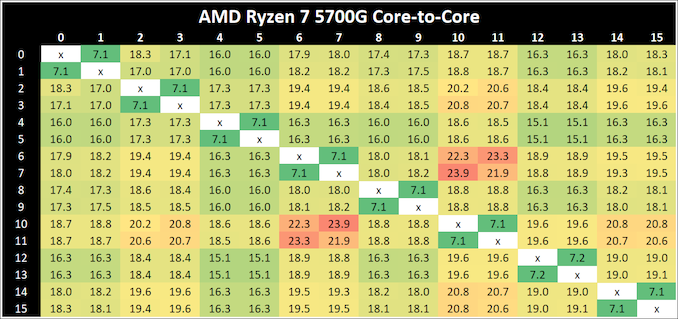
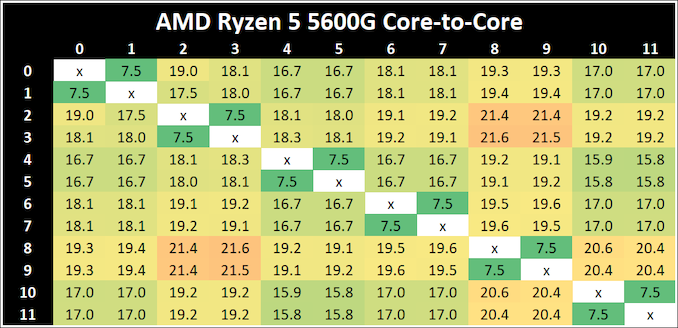
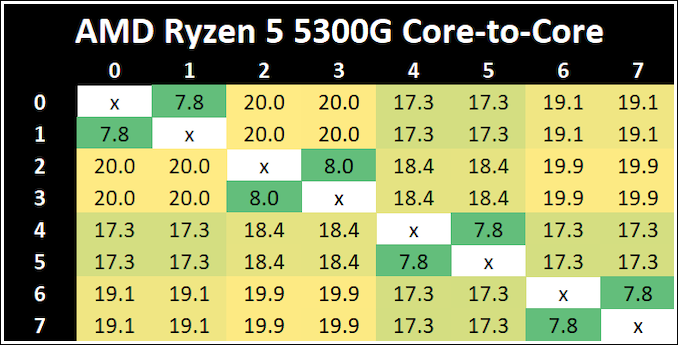
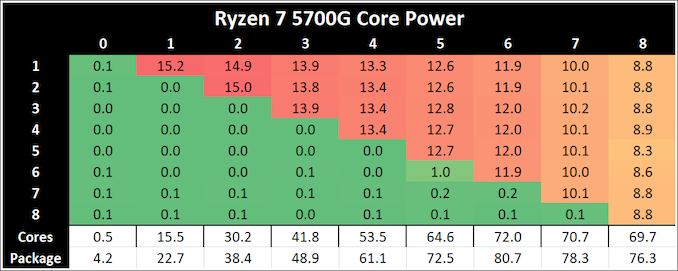

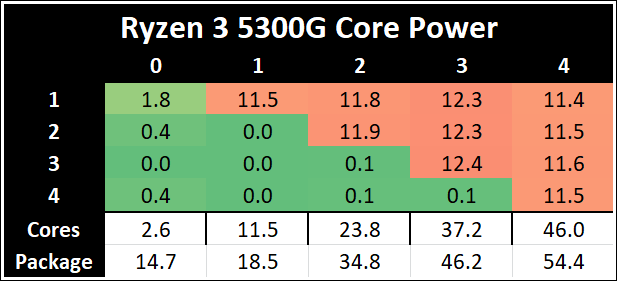
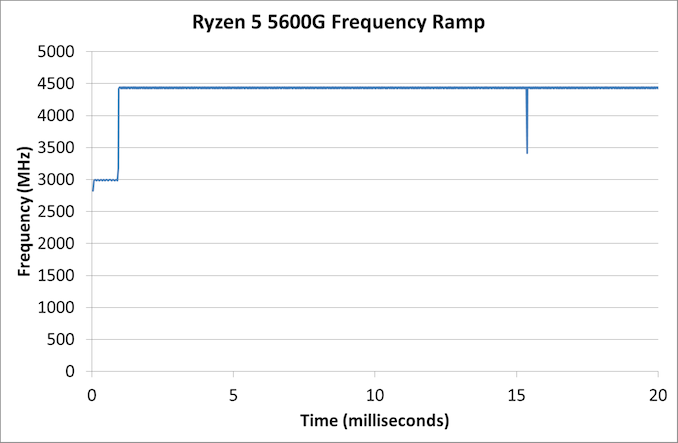








135 Comments
View All Comments
mode_13h - Sunday, August 8, 2021 - link
I mean the gap between 3000G and 5000G APUs. Alder lake will probably also add some downward pricing pressure.mode_13h - Sunday, August 8, 2021 - link
In the meantime, I noticed Ryzen 5 3300X is back in stock, and available for $150!GeoffreyA - Sunday, August 8, 2021 - link
My humble 2200G is running well, but eventually, when I've got money to spare, I'd like to get something like a 5600G. Encoding performance is close to tripled, which is attractive. Heck, even the 5300G looks quite nice.Samus - Monday, August 9, 2021 - link
That's true. The Ryzen APU's have been so ridiculously fast for generations that even a 2018-era CPU is entirely competitive today. It isn't like games are going to play that much different - we'll have to see how demanding Battlefield 2042 is.GeoffreyA - Tuesday, August 10, 2021 - link
I think post Sandy Bridge, most CPUs have been holding up a lot longer than they used to.ballsystemlord - Saturday, August 7, 2021 - link
The "Ryzen 5 APUs (65W)" table is still mixed up. The 5600G isn't an 8 core APU. Neither is the 4650G. You should probably double check the other quoted specs.Spelling and grammar errors:
"The Ryzen 7 5700G has the quickest thread-to-thread latency, however does offer a single slowest core-to-core latency."
Incorrect grammar:
"The Ryzen 7 5700G has the smallest thread-to-thread latency. However, it also offers the single slowest core-to-core latency."
"Interestingly this processor uses more power when six cores are loaded."
Missing comma:
"Interestingly, this processor uses more power when six cores are loaded."
"Photoscan shows good gen-on-gen performance uplifts, with the 5700G on par with the 11700K despite being lower powered."
Incorrect grammar:
"Photoscan shows good gen-on-gen performance uplifts, with the 5700G on par with the 11700K despite using less power."
"GIMP is a funny test where it gets harder the more cores you have - that's why the quad cores win here. However slow quad cores (like the 2400G still let you down."
Missing paranthesis:
"GIMP is a funny test where it gets harder the more cores you have - that's why the quad cores win here. However slow quad cores (like the 2400G,) still let you down."
"We're still running the tests for the Ryzen 5 5600G and Ryzen 3 5300G, but the Ryzen 7 5700G scores strong."
"Strongly" is how you score:
"We're still running the tests for the Ryzen 5 5600G and Ryzen 3 5300G, but the Ryzen 7 5700G scores strongly."
"Historically a processor with integrated graphics fit the bill."
Missing comma:
"Historically, a processor with integrated graphics fit the bill."
"... then someone like my father can browse the web and do office stuff on his 32-inch display and join the weekly family zoom call without having to sit there for the system to respond."
Sitting is what we normally do unless we have a standing desk:
"... then someone like my father can browse the web and do office stuff on his 32-inch display and join the weekly family zoom call without having to wait around for the system to respond."
"The problem with these though is that the 5300G isn't coming to market, at something like $159."
Missing comma:
"The problem with these though, is that the 5300G isn't coming to market, at something like $159."
"However it is not always the silicon that matters."
Missing comma:
"However, it is not always the silicon that matters."
"In the same way that every year we get more performance, every year the required specifications for modern games go up."
"goes" not "go".
"In the same way that every year we get more performance, every year the required specifications for modern games goes up."
"Not only that but new technologies such as AMD?s Fidelity SuperFX Resolution are aimed at getting a better experience with less compute power."
Missing comma:
"Not only that, but new technologies such as AMD?s Fidelity SuperFX Resolution are aimed at getting a better experience with less compute power."
"Moving up to Zen 3 with a larger L3 cache has really unlocked more of the performance in these cores and in the graphics."
You should qualify the type of graphics considiring the closeness of the "in":
"Moving up to Zen 3 with a larger L3 cache has really unlocked more of the performance in these cores and in the integrated graphics."
"The question on that then becomes how much extra will it cost,..."
Missing comma:
"The question on that then becomes, how much extra will it cost,..."
umwmedia - Sunday, August 8, 2021 - link
AMD Ryzen 5000 CPU vs APU Comparisons?WaltC - Sunday, August 8, 2021 - link
Lots of pent-up demand for these APUs. I was impressed that AMD actually got them out in quantity on the release date! In fact, judging by seeing the US AMD store fully stocked with CPUs, including these, for several days running, now, I think it might be safe to say that the CPU shortage--at least for AMD CPUs--is finally coming to an end. AMD store is selling them all for MSRP--so there's no room for scalpers! Perhaps this means the GPU shortages are not long for this world--we can hope.mode_13h - Monday, August 9, 2021 - link
I noticed even the R9 5950X is in stock (Newegg even has it on sale for $805), but we don't know for how long. I'm guessing AMD gets wafers in batches, which leaves open the possibility of another dry spell before long.HankInTexas - Monday, August 9, 2021 - link
According to the AMD published specs, this APU only supports PCIe gen3. So, that hot, expensive Gen 4 M.2 NVMe SSD you want to use on your new motherboard will not achieve the speed you paid dearly for.